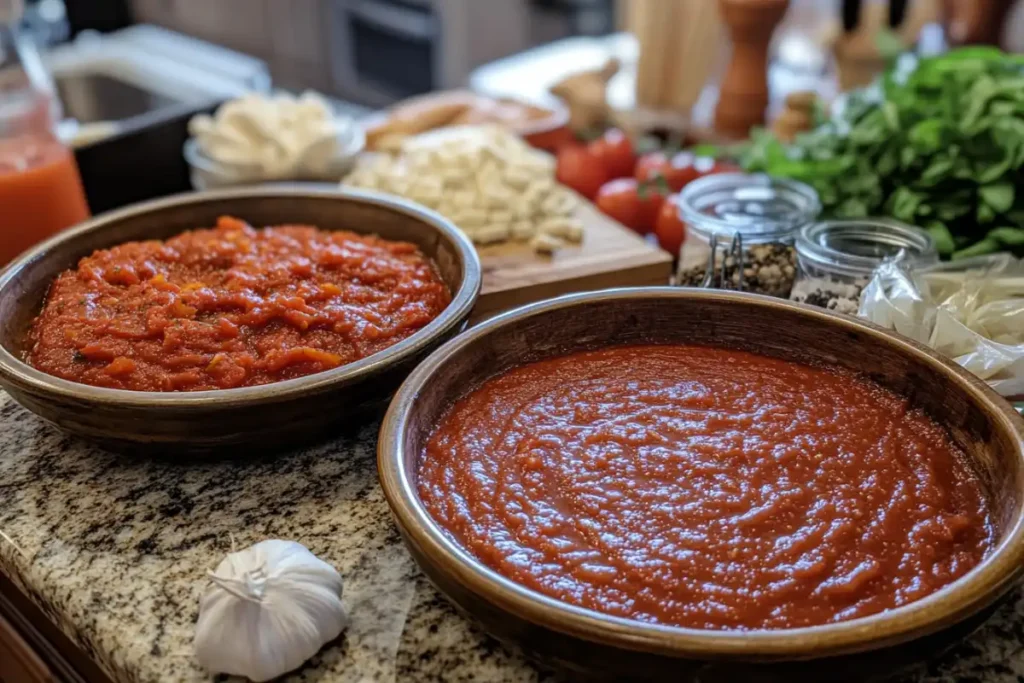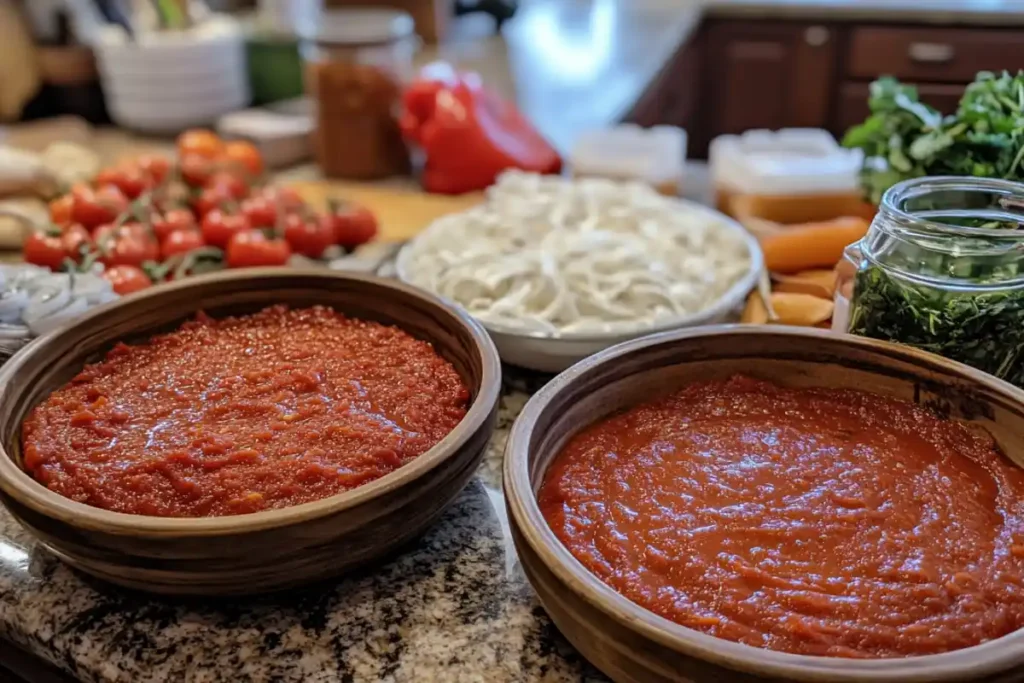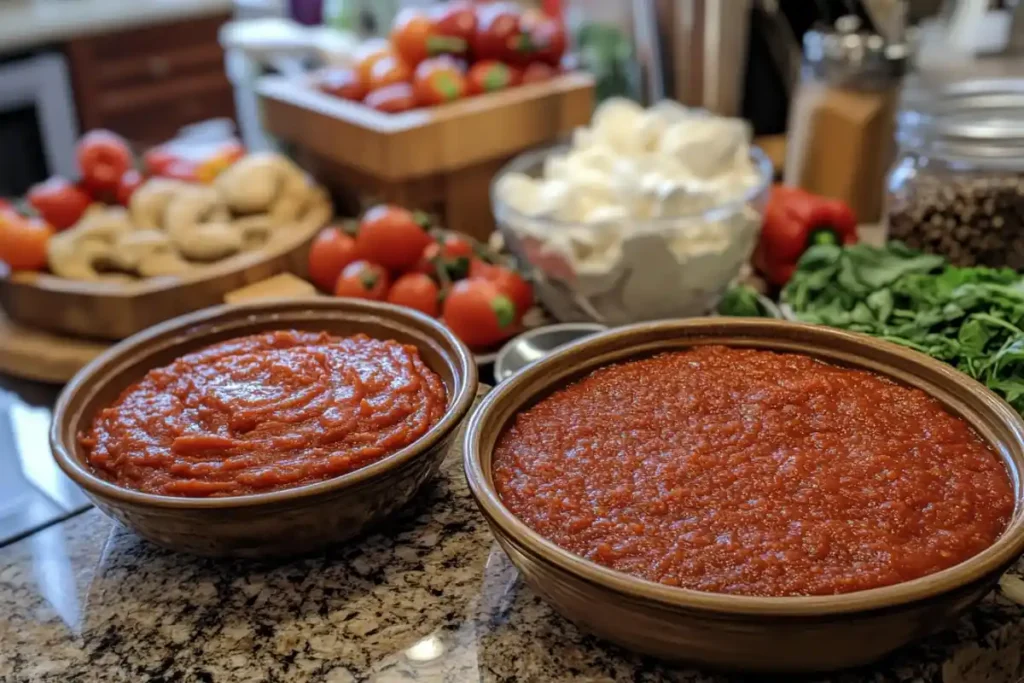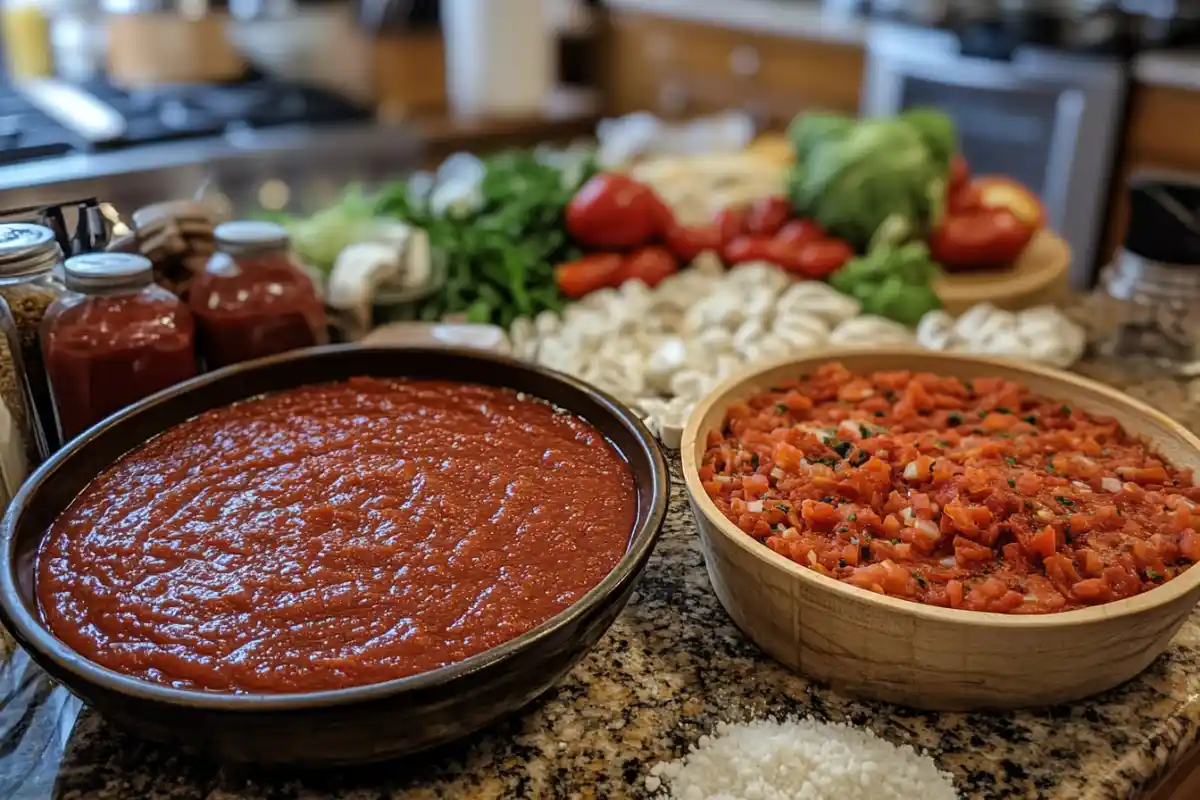When preparing a delicious pizza, one of the most important decisions to make is choosing the right sauce tomato paste or sauce for pizza. While there are several options available, the two primary choices for a tomato-based sauce are tomato paste and tomato sauce. These two ingredients can make a significant difference in the overall flavor and texture of your pizza. Understanding the distinctions between them and knowing when to use each can help elevate your pizza-making skills.
In this article, we’ll dive into the differences between tomato paste or sauce for pizza, providing insight into their unique characteristics and culinary applications. Whether you’re aiming for a rich, intense flavor or a milder, smoother base, this guide will help you make an informed decision for your next pizza night.
For those who are exploring different kinds of pizza, it’s worth noting the versatility of sauces. For instance, if you’re curious about creating a flavorful base with a fresh twist, consider checking out the chimichurri tomato pizza recipe, which highlights how a unique sauce can bring out fresh, aromatic flavors.
Key Differences Between Tomato Paste and Tomato Sauce for Pizza
Tomato Paste – A More Concentrated Option
Tomato paste is made by cooking tomatoes down to remove most of their water content, leaving behind a thick, rich concentrate. The end result is a flavorful paste that can be used to create a deeply savory pizza base. It’s the perfect option when you want to intensify the tomato flavor without adding too much moisture to the pizza.
- Consistency: Tomato paste is extremely thick and dense, which makes it ideal for spreading on the pizza dough without making it soggy.
- Flavor Profile: The concentrated nature of tomato paste means it has a much more intense tomato flavor compared to tomato sauce. It’s perfect if you want your pizza to have a bold, robust taste.
If you want to explore the versatility of tomato paste in pizza and other dishes, you may want to visit the buffalo wild wings garlic parmesan chicken recipe, where rich, concentrated flavors shine through similar to how paste enhances pizza sauce.
Tomato Sauce – A Milder and Smoother Alternative
On the other hand, tomato sauce is much thinner and lighter than tomato paste. It is typically cooked with additional ingredients such as garlic, onions, and herbs, which creates a more complex, savory base for pizza. If you prefer a smoother texture and a less intense tomato flavor, tomato sauce is the better choice.
- Consistency: Tomato sauce is thinner and smoother than tomato paste. This makes it easier to spread evenly over the pizza dough.
- Flavor Profile: The flavor of tomato sauce is often milder and more balanced. It’s usually seasoned with additional spices, which allows it to complement various pizza toppings.
For a deeper dive into tomato sauce options, especially in a variety of dishes, consider learning more from the sourdough bagel recipe, where a well-seasoned sauce serves as the perfect base for a variety of savory flavors.
How to Choose Between Tomato Paste or Sauce for Pizza

Choosing between tomato paste or sauce for pizza depends on the kind of pizza you want to make and the texture and flavor you’re aiming for.
Consider the Desired Flavor Intensity
- Rich, Bold Flavor: If you’re looking for a more robust and intense tomato flavor, tomato paste is the ideal choice. Its concentrated nature adds depth to the pizza base without overwhelming other ingredients.
- Milder, Subtle Flavor: If you want a more balanced sauce that lets the other toppings shine, tomato sauce is a better option. It’s lighter in flavor and complements a wide variety of toppings.
Think About the Consistency
- Thicker Sauce: For a pizza that holds up well under the toppings and doesn’t run, tomato paste provides a perfect spreadable consistency.
- Thinner Sauce: If you prefer a sauce that spreads easily and offers a smooth texture, tomato sauce is the go-to choice.
How to Cook Tomato Paste or Sauce for Pizza
Now that we’ve explored the basic differences between tomato paste or sauce for pizza, it’s time to dive into how you can prepare these sauces to create the best possible pizza. The preparation of these ingredients plays a significant role in achieving the perfect balance of flavor and texture. Below, we’ll go step-by-step through how to prepare both tomato paste and tomato sauce for pizza.
Preparing Tomato Paste for Pizza
Tomato paste is concentrated and thick, so it requires a bit of preparation to make it suitable for spreading on your pizza. Here’s how to do it:
1. Rehydrate the Paste
Since tomato paste is very thick and dense, you’ll need to thin it out to a spreadable consistency. Start by adding water or tomato juice to the paste.
- Ratio: A good starting point is mixing about 1 part water to 2 parts paste. If you want a thicker sauce, use less water.
- Alternative: For a richer flavor, you can use a bit of olive oil or broth instead of water to thin the paste. This will add extra flavor to the sauce.
By preparing tomato paste this way, you create a sauce that’s easy to spread on pizza without making the dough soggy. If you need more ideas for creating flavorful sauces, you may find the chimichurri tomato pizza recipe a helpful source of inspiration.
2. Add Herbs and Seasonings
Once you’ve rehydrated the tomato paste, it’s time to infuse it with flavor. Tomato paste has a deep, rich base, so the seasonings you choose will be important.
- Basic Herbs: Add oregano, basil, and thyme for a classic pizza flavor.
- Other Seasonings: Garlic powder, onion powder, and a pinch of sugar can balance the acidity and enhance the sauce’s sweetness.
- Spice It Up: If you like a little heat, consider adding red pepper flakes or a dash of cayenne pepper.
Preparing Tomato Sauce for Pizza
Tomato sauce is often ready to use right out of the can, but when making pizza, it’s best to cook it down slightly to achieve the perfect consistency. Here’s how to prepare it for your pizza:
1. Cook the Sauce
If you’re using store-bought tomato sauce, it may be a bit too watery for pizza. To fix this, cook it down to achieve the right thickness.
- Simmering: Pour the tomato sauce into a saucepan and simmer it over low to medium heat. Stir occasionally to prevent burning.
- Reducing: As the sauce simmers, it will thicken and intensify in flavor. This process can take 20-30 minutes, depending on the consistency you prefer.
For further inspiration on making flavorful sauces, you might want to check out the garlic parmesan chicken pasta recipe, where a similar method is used to enhance the sauce’s texture and richness.
2. Seasoning the Sauce
Seasoning is critical to making tomato sauce flavorful for pizza. While tomato sauce is typically less concentrated than tomato paste, you can still add various herbs and spices to enhance the overall flavor profile.
- Herbs: Add basil, oregano, and thyme to bring out the classic pizza flavors.
- Spices: Garlic powder, onion powder, and a little bit of sugar will balance the acidity in the sauce.
- Salt and Pepper: Season to taste with salt and freshly ground black pepper.
3. Add Tomato Paste for Richness (Optional)
If you prefer a thicker and more concentrated sauce similar to tomato paste, you can mix a small amount of tomato paste into the sauce while it simmers.
- Proportions: Start with a tablespoon or two of tomato paste and mix it in well. This will enhance the depth of the flavor without overwhelming the pizza.
Deciding Between Tomato Paste or Sauce for Pizza

Now that you know how to prepare both tomato paste or sauce for pizza, the next step is deciding which one works best for your pizza. Here are a few things to consider when making this decision:
1. Desired Flavor Intensity
- For a Bold, Rich Flavor: If you prefer a stronger, more robust flavor, tomato paste is the better choice. It has a concentrated taste and pairs perfectly with hearty toppings like sausage, pepperoni, or mushrooms.
- For a Milder, Balanced Flavor: If you’re looking for a lighter, subtler base that complements delicate toppings like fresh mozzarella or basil, tomato sauce is the way to go.
You can experiment with both to find your personal favorite. For a pizza with bold flavors, like in the pickle pie pizza recipe, a richer, more concentrated sauce can really elevate the overall dish.
2. Consistency Preferences
- Thicker Sauce: If you prefer a thicker, more substantial pizza sauce, then tomato paste is your best option. It holds its shape well on the pizza dough without running or making the pizza soggy.
- Thinner Sauce: If you prefer a smoother and more fluid texture, tomato sauce is better suited to your needs. It spreads easily and creates a lighter pizza base.
Both options have their place depending on your texture preferences, so don’t hesitate to try both in different pizza recipes to see what works best for you.
3. Preparation Time and Ease
- Quick and Easy: If you need a sauce that can be quickly made, tomato sauce is a more convenient option. Simply heat it up and add your seasonings.
- More Time-Consuming: Preparing tomato paste can take more time as it requires rehydrating and seasoning, but the results are often more intense and flavorful.
Consider what works best for your cooking time when deciding which sauce to use.
Practical Applications of Tomato Paste or Sauce for Pizza

Now that we’ve covered the basics of tomato paste or sauce for pizza and how to prepare both, it’s time to explore some practical applications and tips to enhance your pizza-making experience. Whether you’re a beginner or an experienced cook, knowing when and how to use these sauces will make a significant difference in your pizza quality.
How to Choose the Right Sauce for Different Pizza Styles
One of the key considerations when deciding between tomato paste or sauce for pizza is the type of pizza you’re making. Different pizza styles call for different sauce textures and flavor profiles.
1. Classic Neapolitan Pizza
The classic Neapolitan pizza features a thin, crispy crust topped with fresh mozzarella, basil, and a simple tomato sauce. For this style, a tomato sauce works best because of its light, smooth consistency, which complements the delicate toppings.
- Why Tomato Sauce?: The lighter texture and fresher flavor of tomato sauce let the mozzarella and fresh basil shine through without overwhelming them.
- Preparation Tip: If you’re using store-bought tomato sauce, be sure to cook it down to reduce its watery consistency, making it a perfect base for Neapolitan pizza.
For a closer look at another tomato-based recipe, such as the chimichurri tomato pizza, which uses fresh flavors and a bit of acidity from the tomatoes, you can see how versatile the sauce can be for different styles.
2. Thick-Crust or Sicilian Pizza
For thicker, heartier crusts like Sicilian pizza, you may want to go with tomato paste as it provides a more robust and concentrated flavor that pairs well with the substantial crust and additional toppings, like sausage, olives, or onions.
- Why Tomato Paste?: The thick consistency of tomato paste holds up well on a thicker crust, adding a rich, flavorful base without making the pizza soggy.
- Preparation Tip: Thin out the tomato paste with water or tomato juice, and be sure to season it well to match the richness of the crust.
If you are experimenting with different topping combinations, like the buffalo wild wings garlic parmesan chicken, you’ll see how the thick consistency of tomato paste enhances the overall balance of the pizza.
Customizing Your Sauce for Pizza
While the classic tomato paste or sauce for pizza choices are great, sometimes you might want to add a personal touch. Here are some ways to customize both sauces for a unique twist:
1. Adding Extra Flavor to Tomato Paste
If you’re using tomato paste and want to intensify the flavor, try adding the following ingredients:
- Herbs: Fresh basil, oregano, and thyme can enhance the herbal undertones.
- Sweeteners: A pinch of sugar can balance the acidity and give the paste a smoother, sweeter finish.
- Spices: Garlic powder, onion powder, and a touch of smoked paprika can elevate the flavor, giving your pizza a more complex taste.
For inspiration on flavor adjustments, check out this article on marinara sauce, which highlights how adding herbs and spices can completely change the dynamic of a tomato-based sauce.
2. Elevating Tomato Sauce
Tomato sauce is versatile and can be easily customized to suit your taste. Consider these adjustments:
- Add More Vegetables: Caramelized onions, roasted bell peppers, or even spinach can be added to the sauce for extra texture and flavor.
- Spicy Kick: For those who love heat, incorporate red pepper flakes or fresh chilies into the sauce.
- Creamy Texture: Blend in a little cream or cheese to create a richer, more indulgent sauce that pairs perfectly with pizza.
You can experiment with these ingredients to create a sauce that fits your preferences, much like the ideas presented in the easy sourdough bagel recipe, where creative combinations transform a simple dish into something special.
FAQs
It depends on your preference. Tomato paste provides a thicker, more concentrated flavor, while tomato sauce is lighter and smoother, ideal for a milder taste.
Yes, you can substitute pizza sauce for tomato paste, but you may need to reduce the sauce to achieve a thicker consistency.
For a rich, intense flavor, tomato paste works best. For a smoother, milder base, tomato sauce is a better option.
To make pizza sauce from tomato paste, simply rehydrate it with water or tomato juice, and season with herbs and spices to taste.
Conclusion
Whether you opt for tomato paste or sauce for pizza, the key is understanding how to prepare and adjust each option to suit your personal preferences. Tomato paste offers a richer, thicker sauce with a more concentrated flavor, while tomato sauce provides a lighter, milder base for a smoother pizza experience. By customizing your sauce with seasonings and understanding consistency, you can elevate any pizza to a new level. Experiment with both options and discover the best combination for your perfect pizza.

